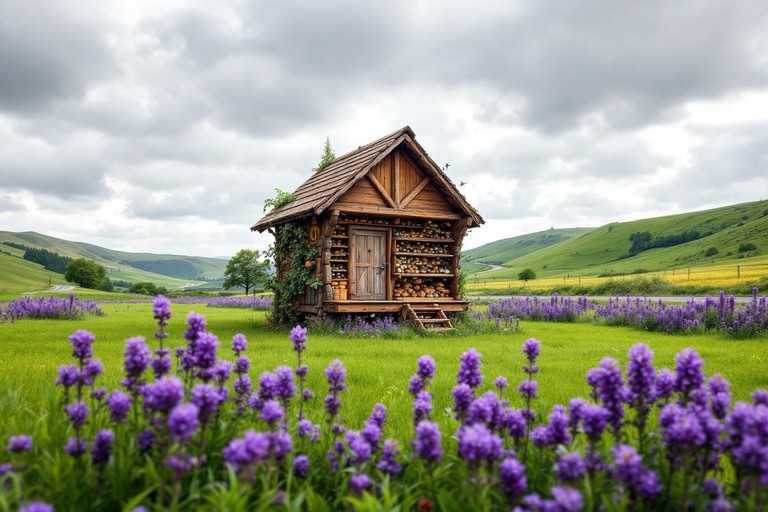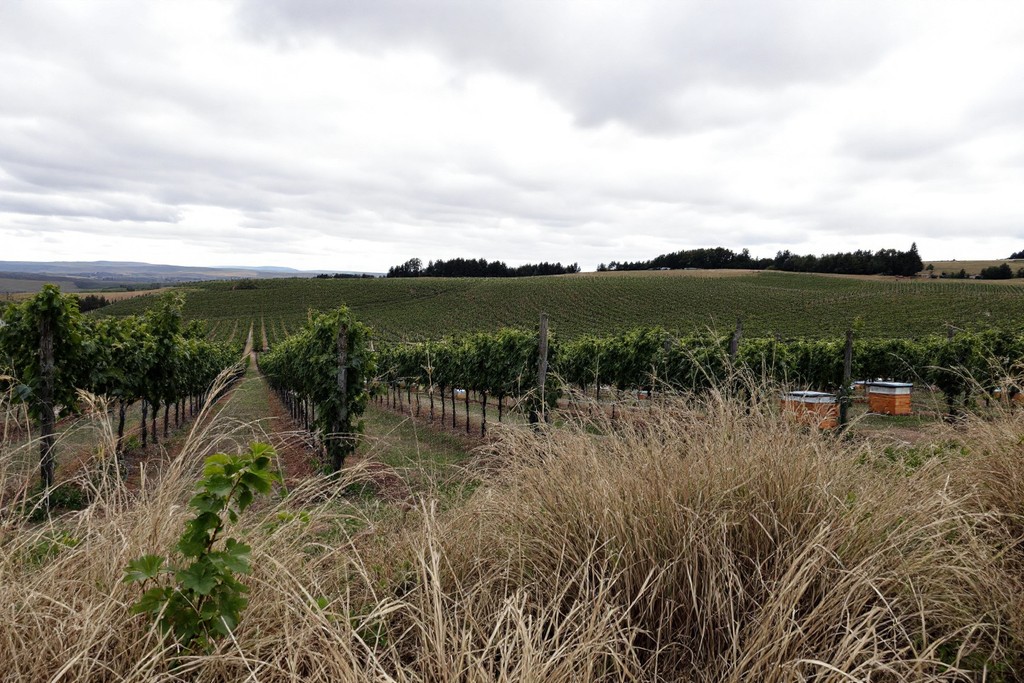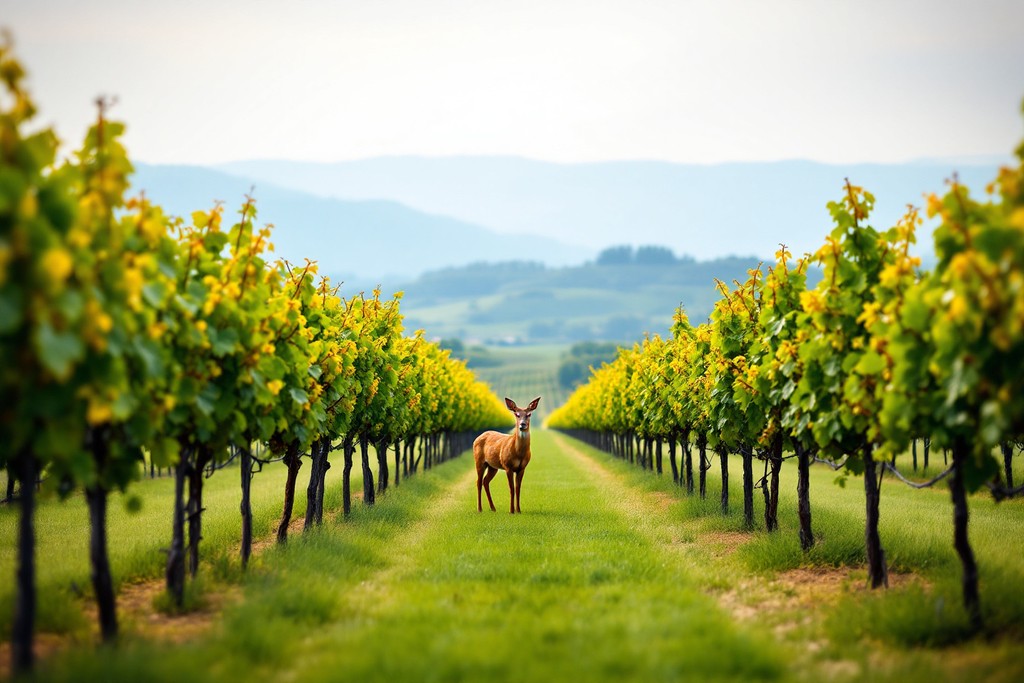
Biodiversity is essential for ensuring the resilience and sustainability of viticultural ecosystems. A vineyard rich in plant and animal species promotes a balanced environment that can better resist diseases, pests, and climate variations. In fact, biodiversity acts as a true natural shield against sudden disruptions that could otherwise ravage crops. Monoculture vineyards are often more vulnerable to diseases and invasions. A diverse ecosystem contains a variety of organisms filling different ecological niches, contributing to the stability of the overall system. For instance, some plants can attract beneficial insects that control pest populations, while others can improve soil structure, facilitating better water and nutrient retention. The presence of hedges, meadows, and surrounding woods also plays a crucial role. These areas host a variety of wildlife, from predatory birds to pollinating insects, each having a specific place and function in the ecosystem. Birds, for example, can help control harmful insects, thereby reducing the need for pesticides. By integrating a mosaic of native plants and preserving natural habitats around vineyards, winegrowers contribute to creating a more robust and sustainable environment. The complex interactions between different species enhance the beneficial effects of biodiversity, thereby reinforcing the resilience of vineyards in the face of current environmental challenges. Adopting viticultural practices promoting biodiversity is not only beneficial for the ecosystem but also for wine production. A balanced ecosystem enriches the soils and improves the quality of the grapes, leading to wines with unique characteristics and better quality. In sum, biodiversity represents an invaluable asset for vineyards, investing in the long-term health and sustainability of the entire viticultural culture.
Insects play a crucial role in protecting vineyards, acting as invisible but extremely effective allies. Ladybugs, parasitoid wasps, spiders, and other predatory insects are key players in the natural control of pest populations. These small protectors help maintain a biological balance, often without requiring human intervention, thus reducing reliance on pesticides. Ladybugs, for example, are true machines for devouring aphids, which can wreak havoc in vineyards by feeding on the sap of young shoots. A single ladybug can consume several dozen aphids per day. Parasitoid wasps, on the other hand, lay their eggs inside pest larvae like caterpillars, which eventually get parasitized and eliminated. Pollinators, such as bees and butterflies, also have a significant, although often indirect, impact on the health of vineyards. Even if the vines themselves do not directly depend on insect pollination, the presence of various pollinators promotes the health of surrounding plants, which in turn support the overall vine ecosystem. These interactions create a robust ecological network that better withstands environmental stresses. The integration of flower strips and hedges in and around vineyards is a practice increasingly adopted by viticulturists. These areas provide habitat and food resources for many beneficial insects as well as other forms of wildlife. Flower strips can also serve as ecological corridors, facilitating the migration and dispersal of beneficial species across the viticultural landscape. By understanding and promoting the role of insects in protecting vineyards, winegrowers can adopt more sustainable and ecologically responsible approaches. Instead of systematically resorting to chemical treatments, it becomes possible to leverage nature to manage pest populations. This approach not only preserves local biodiversity but also improves the quality and reputation of wines produced, benefiting from a healthier and more balanced environment.

Native plants occupy a prime position in vineyards, not only for their aesthetic contribution but mainly for their agronomic and ecological advantages. Indeed, these native plants play an essential role in preserving and enriching viticultural soils, thereby contributing to wine production of quality. Native plants are perfectly adapted to local conditions, allowing them to thrive without requiring significant external resources. Their adaptation to local climates, soils, and hydrological cycles makes them ideal partners for maintaining soil balance on vineyard terrains. By rooting deeply, these plants increase soil porosity, improving water and air circulation. They also promote the activation of essential microbial life, crucial for the health of the terroir. A healthy soil rich in organic matter is key to a robust and productive vine. Native plants, such as local herbs and legumes, can help fix nitrogen from the air thanks to symbiotic bacteria present in their roots. This reduces the need for chemical fertilizers while naturally enriching the soil. Moreover, the decomposition of their biomass adds valuable organic matter, thereby improving soil structure and water retention capacity. Moreover, native plants act as natural barriers against erosion, a problem often exacerbated on sloping terrains where many vineyards are located. They protect soils from the erosive action of wind and rain while stabilizing slopes and embankments. This is particularly valuable to prevent nutrient loss and maintain a fertile topsoil layer. By integrating native plants into the cover crop strategies, winegrowers can also create favorable habitats for a variety of local fauna, including beneficial insects, birds, and small mammals, all of which contribute to a balanced ecosystem. Interactions between these plants and fauna encourage a healthy and diverse environment, crucial for the long-term sustainability of vineyards. Thus, native plants represent a smart and ecological investment for viticulture. Their integration into viticultural practices offers multiple benefits, ranging from soil quality improvement to reduced chemical input requirements while promoting local biodiversity. In short, native plants are true allies, not only for soils but for the entire viticultural ecosystem.
The interactions between wildlife and viticultural cultures are complex and multifaceted, encompassing both beneficial aspects and potential challenges. Understanding these interactions allows winegrowers to better manage their parcels while contributing to the conservation of local biodiversity. Birds, for instance, play a fundamental role in viticultural ecosystems. Raptors, like hawks and owls, help control populations of small mammals that can damage vine stocks by nibbling on their roots or fruits. By installing perches and nesting boxes, winegrowers can attract these natural predators, thereby reducing the need for chemical rodenticides. However, birds are not solely allies. Some birds, such as starlings, can cause considerable damage by directly feeding on ripe grapes. Non-lethal deterrent methods, like anti-bird nets, modern ultrasonic scarecrows, and even herding dogs, can be employed to protect crops while respecting ecological balances. Mammals, like foxes and deer, also bring their share of interactions. Foxes participate in the regulation of small rodent and other pest populations, while deer, although majestic, can damage vineyards by browsing young shoots and vine leaves. Suitable fencing and the management of peripheral natural habitats can help minimize negative impacts while allowing these animals to coexist with viticultural activities. The interactions between vines and wildlife are not limited to visible species. Soil microfauna, such as earthworms, play a crucial role in the health of viticultural soils. They decompose organic matter and improve soil structure, thus promoting better nutrient absorption by vine stocks. Practices such as no-till and reduced chemical pesticide use encourage the presence and activity of these essential organisms. The integration of mixed cover crops and flower strips can attract various insects and small animals that contribute to pollination and biological pest control. By maintaining and enhancing natural habitats at the edges of vineyards, winegrowers create ecological corridors favoring biodiversity and beneficial interactions. In conclusion, the interactions between wildlife and viticultural cultures are multiple and require a balanced and informed management approach. By adopting sustainable viticulture practices and promoting respectful coexistence with local wildlife, winegrowers can not only improve the health and resilience of their vines but also contribute to the preservation of local ecosystems.

Sustainable viticultural practices are essential for preserving local fauna and flora, contributing to the creation of a balanced environment that benefits the vine, surrounding ecosystems, and future generations. Adopting these practices involves a holistic management of vineyards, integrating environmentally-friendly farming techniques and biodiversity conservation strategies. One of the first steps toward sustainable viticulture is the reduction of chemical phytosanitary product use. Integrated pest management (IPM) practices minimize the reliance on pesticides by promoting natural control methods. For example, introducing natural predators, like ladybugs to combat aphids, or using pheromones to disrupt pest reproduction cycles, offers effective and ecological solutions. Choosing disease-resistant grape varieties, such as those resistant to downy mildew or powdery mildew, also helps reduce chemical product use. Adapted cultural practices, such as airy pruning, can reduce conditions favorable to disease emergence by improving air circulation around grape clusters. Moreover, the use of composts and organic amendments enriches the soil and strengthens vine vigor, making them more resilient to biotic and abiotic stresses. The management of ground cover is another key practice. Cover crops, such as legumes and native flower mixes, play a crucial role in soil fertility and erosion prevention. They also offer habitats and food sources for a multitude of beneficial insects and pollinators. By sowing rows of cover crops between vines, winegrowers promote biodiversity while improving soil structure and health. Reasoned irrigation and water conservation are fundamental components of sustainable viticulture. Techniques like drip irrigation allow for more efficient water use, reducing plant water stress while conserving a precious resource. Additionally, collecting and reusing rainwater and irrigation water can contribute to reducing the ecological footprint of vineyards. Lastly, the certification of organic or biodynamic agriculture vineyards is increasingly favored. These certifications guarantee the adherence to sustainable agricultural practices and biodiversity protection. Biodynamic vineyards, in particular, use special preparations to energize soil and plants, as well as lunar and cosmic calendars for viticultural work, seeking harmony with natural cycles. In summary, sustainable viticultural practices require an integrated and proactive approach to manage vineyards in an environmentally-friendly and respectful manner. By adopting these methods, winegrowers not only preserve local fauna and flora but also ensure the quality and authenticity of the wines produced. In an increasingly environmentally conscious world, sustainable viticulture is a crucial pillar for the future of the wine sector.
Necessary cookies are absolutely essential for the website to function properly. This category only includes cookies that ensures basic functionalities and security features of the website. These cookies do not store any personal information.
Any cookies that may not be particularly necessary for the website to function and is used specifically to collect user personal data via analytics, ads, other embedded contents are termed as non-necessary cookies. It is mandatory to procure user consent prior to running these cookies on your website.